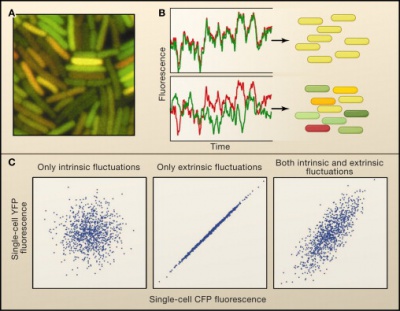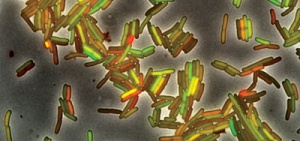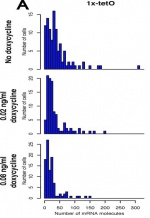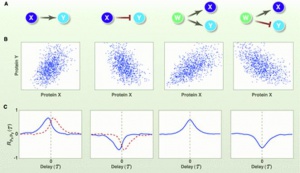CH391L/S14/StochasticGeneExpression
Contents |
Introduction
Stochastic gene expression is the randomness and unpredictable pattern that occurs in gene transcription or translation mechanisms. The nature of stochastic gene expression is due to the small number of DNA or RNA molecules in cell, which has only a few copies per cell. This makes gene expression a discrete and random biochemical reaction. As a result, gene expression can vary from one cell to another, making genetically identical twins have traits in different level. Scientist found the stochastic fluctuation, or “noise”, plays an important part in gene expression and regulation, and many different experimental methods were used to quantify the nature of noise. Two kinds of noise were introduced in earlier studies: intrinsic noise and extrinsic noise. Extrinsic noise is cause by the fluctuation of concentration or location of cellular components that regulate or facilitate gene expression, such as polymerase and ribosome. These factors can vary from one single cell to another, thus different cells with identical genome can have different expression profile. On the other hand, given two cells that have not only the same genome but also the same states of cellular components, the expression rate of a certain gene can still vary. This is due to the inherent randomness of biochemical reaction probabilistic nature of a microscopic event. By study and compare different expression distribution profile, scientists are able to analyze the gene regulatory mechanism and understand how two gen interacting with each other.
Experimental study of stochastic gene expression identification

The first study that observed stochastic gene expression was in 1957, when Novick and Weiner try to induce beta-galactosidase in mouse cell. Instead of increasing the expression level in all cell, they found that only a proportion of the cells had an increased expression level. In 2002, Elowitz and Ozbudak used fluorescent protein (CFP and YFP) to experimentally quantify differential gene expression in E. coli. They used the same promoter to express YFP and CFP and proposed the intrinsic and extrinsic noise concept by analyzed the gene expression level correlation between two fluorescent protein. They found that different promoter can have different effect on intrinsic or extrinsic noise, and while intrinsic noise can be diminish by increasing the mRNA copy number, the extrinsic noise has a more complicated profile corresponded to mRNA translation level.
Mathematical model of stochastic gene expression
Two models were proposed to discuss the rate of gene expression:
Poisson expression statistics
The simplest model of single gene expression is a first order reaction:
dm⁄dt = kR - γR*m
Where m is the concentration of expressed gene, kR is the reaction rare constant, and γR is the rate constant of degradation. However, this approximation is not applicable when the total number of m is small. In such case, the expression rate equation can be written as:
kR*P[m] = γR*(m+1)*P[m+1]
Where P[m] is the probability of having m transcripts, and kR*P[m] is the rate of producing an additional copy, which will equal to the rate of degradation from m+1 transcript if equilibrium is possible. The equation can only be possible when the distribution of m is a Poisson distribution, which can be showed with single-molecule assay to detect the precise location of individual mRNA molecule.
Two state model of gene regulation
The Poisson model is good at predicting constitutive gene but not regulated gene. The deviation from Poisson distribution can be contributed to the regulator mechanism of the gene. The Fano factor, which is the ratio of variance (σ) and mean transcript copy number (M), is used to quantify the level of deviation from Poisson distribution. Fano factor is equal to one at Poisson distribution.
F = σ^2⁄M
To model a two-state regulatory system, two constants Kon and Koff were introduced and defined as the transition rate of two states. Gene is available for translation at on-state while the binding site for ribosome or transcription factor is blocked at off-state. At the same mean copy number of RNA, the Fano number is close to 1 when Kon is much larger than Koff, and the model is similar to Poisson distribution. When Koff is larger than Kon, the gene is not available for most of the time, thus a translation burst (large amount of transcript are produced in a short period) can happen at this case and the Fano factor is large.
Understand gene regulatory mechanism with gene expression distribution profiles
The patterns of gene expression distribution can provide insight of gene regulatory mechanism. To quantify single gene expression level, single-molecule fluorescent in situ hybridization (smFISH) is used. mRNA molecules were quantified in intact cells and gene distribution profile can be built for different model. For example, in 2008 Zenklusen et al. found three housekeeping genes have an expression profile that matches to the constitutive gene expression model. Also in 2006, Raj et al. had studied the gene expression profile in mammalian cell and found the gene expression distribution matches to the second type, the burst expression, of the two-state model.
Study the correlation of noise pattern between two genes can help the scientist to reveal the regulatory mechanism. The expression distribution of two genes can be monitored at the same time in the same cell with the help of smFISH. In 2011, Gandhi et al. analyzed the correlation of expression pattern between genes which regulated by the same or different promoter under steady state. They found many genes are highly correlated with each other after induction; on the other hand, the constitutive genes are not as correlated as regulated genes. In another study, the same concept was employed to determine the causal relationship between two genes. In 2006, Dunlop et al. tested the dynamic correlation between two proteins X and Y for different regulatory motifs. They measured how the fluctuations of Y at different time relate with protein X, which helps them to understand which molecule is the activator, whether the regulation is repressive or inductive, or both molecules are regulated by another molecule.
iGEM project
Many iGEM projects have included the stochastic gene expression model in their study to build a reliable gene expression model. For example, in 2012 the Columbia team used the stochastic model to build a gene-modified detection bacterium that can detect plant pathogen. In 2013 the BIT team also use the model to build the network in their quorum-sensing bacteria and RNA-thermometer system.



